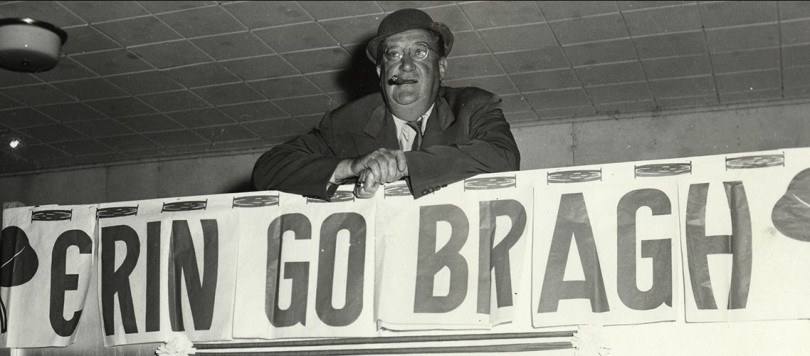
Memories of St. Patrick’s Day and Other Parties at Dodgertown
By Robert Schweppe
The St. Patrick’s Day Party at Dodgertown, Vero Beach, Florida, started out to be just a party to enjoy the international day of celebrating everything Irish. But over time at Dodgertown, the Irish holiday became much more than just a party.
Walter O’Malley, whose family dates back to County Mayo, Ireland was always a superb host with his wife, Kay, when the Dodgers began their March 17th tradition in 1951. In time, his son Peter, President of the Dodgers, and his sister Terry, would take over that role.
Even though the Dodgers already had their Spring Training facility in Vero Beach, Florida, Holman Stadium was not yet constructed, and the bulk of their exhibition game schedule was played in Miami. So, the first Dodger St. Patrick’s Day Party in 1951 was held at the Sea Gull Hotel on the Beach in Miami Beach. When the Dodgers arrived at the hotel on March 8th, the hotel owners, Arthur, Ike, and Jack Evans held a reception for the ball club. Walter O’Malley, in appreciation of the hospitality shown to him and his team, chose St. Patrick’s Day to reciprocate the Evans’ brothers kindness. O’Malley even invited the Dodgers’ National League nemesis, the New York Giants, to be part of the festivities, and the Dodger Spring Training tradition was born.
“He (Walter O’Malley) knew how to put on a fun party. His favorite was our annual St. Patrick’s Day Party each Spring at Dodgertown, Vero Beach, Florida.”
Peter O’Malley
National Baseball Hall of Fame Induction Speech for Walter O’Malley, July 27, 2008.
The Giants regularly had held pre-season training in Arizona, but in 1951, the New York Giants and New York Yankee teams switched Spring Training. The Giants came to Florida and the Yankees went to Arizona and so it was the Giants who joined the Dodgers at the event.
A cake for the 1951 St. Patrick’s Day was decorated “Welcome Irishmen” with baseball bats listing “Brooklyn” on one side and “Giants” on the other. But, after the Giants won the 1951 National League playoff and prevented a Dodger World Series, the Giants became “Don’t Invite ‘Ems.” However, the Giants returned to Arizona for the 1952 Spring Training. From then, on the Dodgers never shared the Day of the Irish with their noted rivals.
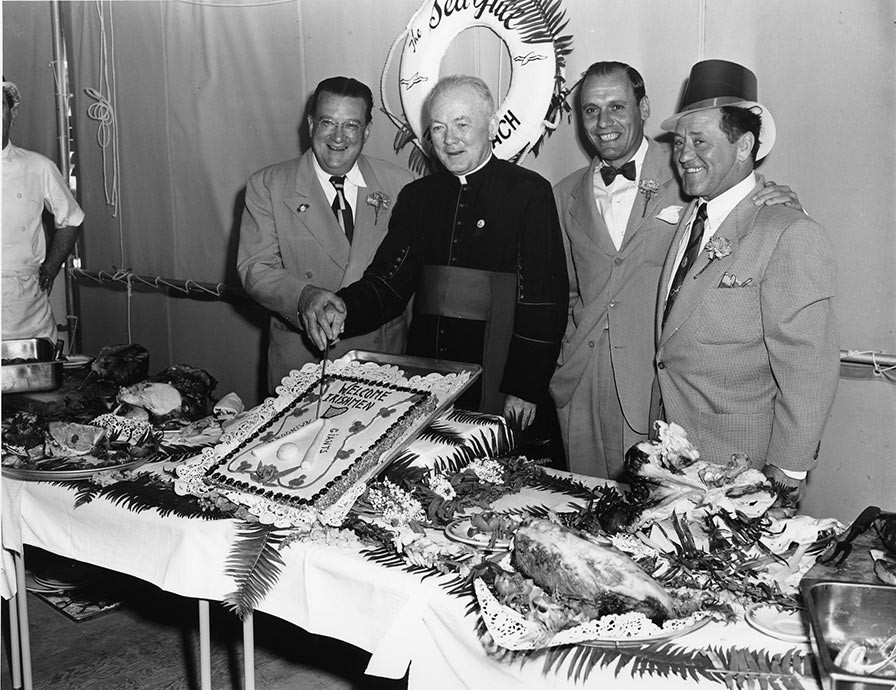
On March 17, 1951, the first St. Patrick’s Day party hosted by Dodger President Walter O’Malley for baseball club officers and press was held at the Sea Gull Hotel in Miami Beach, Florida. They celebrated with the New York Giants, as they were conducting Spring Training in Florida that season and not at their usual Arizona site. (L-R): Walter O’Malley; Monsignor William Barry of St. Patrick’s Catholic Church in Miami; Buzzie Bavasi, Dodger vice president; and Jocko Conlan, National League umpire.
Copyright © Wide World Photos/AP
The priestly blessing at the 1951 St. Patrick’s Day was provided by Monsignor William Barry, of (where else) St. Patrick’s Catholic Church located in Miami. The beloved clergyman would later have Barry University in Miami named for him.
Unfortunately, no printed invitation for the first O’Malley-Dodger St. Patrick’s Day party exists. In later years, the printed invitation containing the menu would become more elaborate as the tradition grew.
The 1952 party invitation definitely displayed the wry Irish humor of Walter O’Malley. The front page, printed in green letters read, “Read Mille Failte” (English translation is ‘A Hundred Thousand Welcomes’). On the inside flap, written was “The O’Malley of County Mayo and the Brooklyn Dodgers ask you to witness the signing of a Free Agent, a big broth of a load, SAINT PATRICK himself, and his Shillelagh, who will stabilize the Chucking Staff (for Chuck Dressen, Dodger Manager) and give Great Depth to the Bench and insure against late season Catastrophes,” referring to the 1951 playoff loss to the Giants. One page in the 1952 invitation listed the dignitaries of the Brooklyn Dodgers and referred to them as Admiral (Red) Barber, Marshal (Connie) Desmond, and the Younger (Vin) Scully, the Dodger broadcasters.
The 1952 menu items for St. Patrick’s Day dinner weaved the names of team personnel with food items. There was “Alston (Walter) potato salad with Fresco” (Thompson, Vice President). “Lime Sherbet Lavagett’O (Coach Cookie); High balls (Andy) (Dodger scout); Boiled Carey (John, scout); Potatoes garnished with O’Holman” (Bud Holman, Vero Beach business and community leader). The 1960 invitation reflected the departure of Dodger Coach Charlie Dressen to manage the Milwaukee Braves as the item read, “Alston Mixed Salad Without Dressen.”
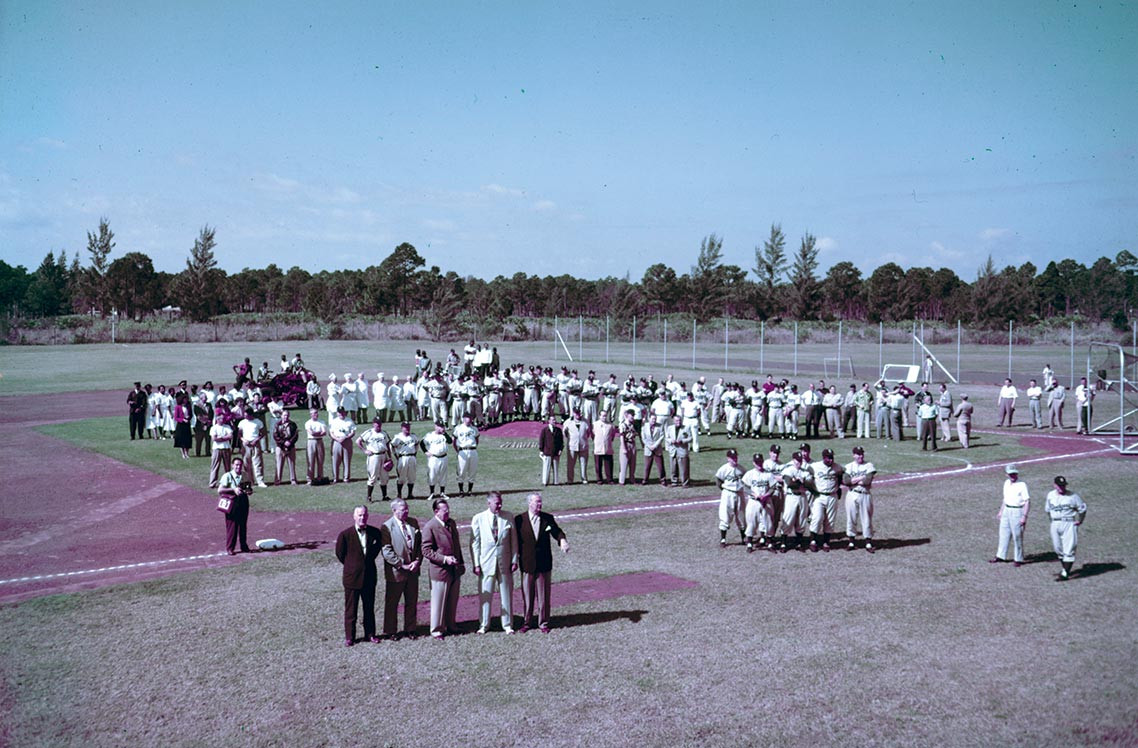
Dodgertown, Vero Beach, Florida, Field No 1. A large portion of the Dodger staff necessary to put on Spring Training for the players is assembled, circa early 1950s. They includes cooks, housekeeping, instructors, and players. In the front row are (L-R) Dodger Vice President Fresco Thompson; Board of Directors Member Hector Racine; Dodger President Walter O’Malley; Co-owner John L. Smith; and Board of Directors Member Harry Hickey. Jackie Robinson is visible in the front players group, second from the right.
Spring Training is no vacation resort. The seven-day work week at Dodgertown started early with breakfast, staff and player arrivals, treatment in the training room, stretching, pitching, fielding, and hitting workouts, quick lunches, exhibition games, minor league games, late individual afternoon workouts, daily review of players by the major league staff and scheduled nighttime meetings to evaluate the progress of minor league players and teams. It takes all kinds of people to run a Dodgertown camp. The manager, field staff, trainers, medical staff, instructors, broadcasters, coordinators, clubhouse personnel, executives, front office staff, and scouts are all away from home and families for an extended period.
Everyone looked forward to St. Patrick’s Day because it was a night of Irish fun, food, drink, and stories. Dodgertown always had plenty to do every day for residents and players with a pitch-and-putt golf course and later the nine-hole and 18-hole public courses. There was an on-base movie theatre showing recent films, game room, and there were some “off-base outings” such as dinner or bowling. St. Patrick’s Day was designed to bring the Dodger organization together for one festive night.
The party was meant to be as Irish as can be. Green is the color of the day from clothes to food to hats to decorations to table settings to flowers to the beer to ice cubes and outlandish outfits to capture the moment. Dodger players would wear green caps for the exhibition games and the game bases were painted green. The Dodgers were always given a spring training priority to be home St. Patrick’s Day. Invited guests had their names in calligraphy on one side of designed cardboard shamrocks that had been cut from Irish whiskey boxes, the brand seen on the back side. Banners read, “Erin Go Bragh” where in 1977, Walter O’Malley said it meant, “Beat the Reds,” the 1975 and 1976 World Champions and Dodger rivals. The Dodgers went on to win the 1977 National League pennant.
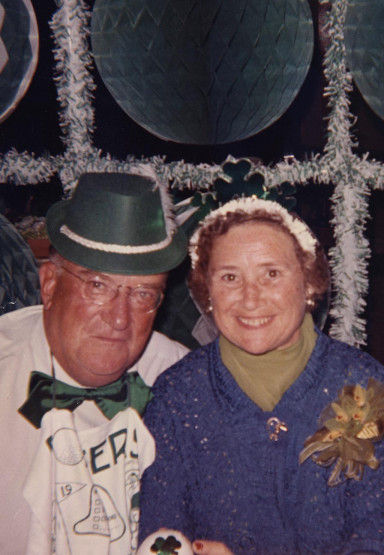
Walter and Kay O’Malley were hosts of the annual St. Patrick’s Day parties at Dodgertown, Vero Beach, Florida.
People wore clothes they rarely wore during the year. Shamrock hats, oversized bow ties and Irish bonnets were in fashion. Hitting instructor Dixie Walker wore a button that read, “I’m a giant leprechaun.” Sometimes the wilder the Irish display, the better. Some would paint their nose green. Clubhouse man John Griffin, known for his remarkable dress-ups, would dress in short pants and wear a hat to resemble a leprechaun. Walter O’Malley himself would join wearing a tam o’shanter, or impressive shirts and jackets in Irish whimsy as he greeted guests during the evening. After the hard work of almost a month to get ready for the season, the night was to be fun.
There was plenty to celebrate the following Spring after a successful season. The Dodgers’ first World Championship in 1955 was commemorated on the 1956 St. Patrick’s Day. Later World Series triumphs in 1959, 1963, 1965 were remembered and the celebrations following the 1981 and 1988 seasons were a great look back to the previous season with an eye of how the club would play in the upcoming season. Through the years, the guest list grew, but in many ways, the organization and its excellence remained the same. From 1951, the first O’Malley St. Patrick’s Day, until 1997, there were just two team presidents, four major league managers, four general managers and three heads of player development.
The Dodger broadcast team had baseball’s greatest broadcaster ever, Vin Scully whose first season was 1950. Jerry Doggett became the added voice in 1956. Scully and Doggett were the only voices until 1977 when Ross Porter was added to the team. Jaime Jarrin joined the Spanish language radio broadcasts in 1959, a World Championship season, and the Hall of Fame voice continued until his retirement following the 2022 season.
The party evolved. No longer just a dinner, the pre-dinner reception became an event unto itself as the guests arrived in the Stadium Club Lounge at Dodgertown. The O’Malleys always set the perfect mood with hors d’oeuvres and liquid refreshment. Irish folk music would be piped through the sound system as strolling musicians played traditional Irish tunes. Artists would be present to perform caricature sketches souvenirs for the evening. Photographers would rove through the celebrants, taking hundreds of photos that would be shared with the guests. Baseball might be discussed in conversation, but it was not a requirement. The workday was over, Spring Training had been long and arduous and a pleasant evening was expected.
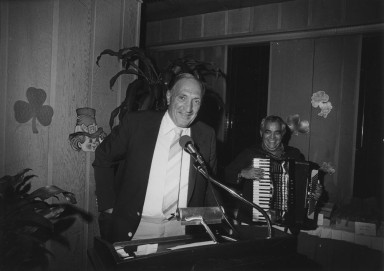
Former Dodger pitcher Ralph Branca addressed the St. Patrick’s Day audience at Dodgertown, Vero Beach, Florida. Branca provided entertainment with a strong baritone voice and even though he was Italian-American, he sang solo all the St. Patrick’s Day favorite songs to entertain the Dodgertown dinner crowd, including “Danny Boy.”
The St. Patrick’s Day party was expected to begin on Dodger time, meaning, on the dot. An announcement would be made through the reception to give guests sufficient time to make their way through the buffet dinner line for an Irish feast, if they chose. Waiting for the guests on the long tables were shades of green everywhere, the Irish standards of corned beef, cabbage, and boiled potatoes, but available stations were set up for prime rib, fish, lobster, and chicken as well as entrees of salad, vegetables, and rolls.
The dinner was meant to be for the staff and special guests of the Dodger family. Audio and video was very limited as the Dodgers wanted people to retain the personal memories they kept of the dinner.
Audience participation was always part of the show. Ralph Branca, a 20-game winner for the Brooklyn Dodgers, a three-time National League All-Star and great friend of Jackie Robinson, had a rich tenor voice. The New York native Italian would give annual renditions of “Danny Boy” to familiar applause. One dinner, Peter Hanson, father-in-law of Walter O’Malley, sang “Take Me Out to the Ball Game” in Swedish. The audience didn’t know the words, but they knew the tune and gave him a fine ovation.
Hall of Fame player and manager Bill Terry, who once played for the New York Giants, and was later President of the Southern League appeared with a quintet of others to sing songs to honor the Irish.
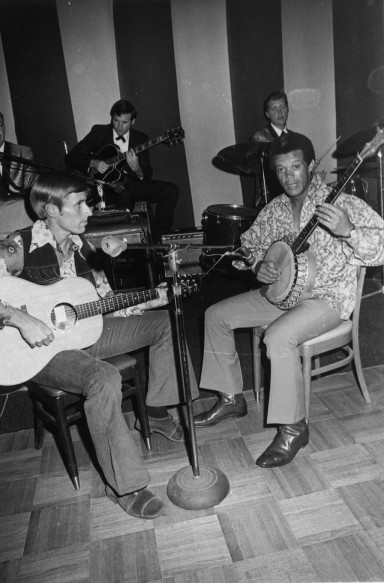
Maury Wills (right) was invited by Walter O’Malley to play the banjo at one of the renowned St. Patrick’s Day parties at Dodgertown, circa early 1970s. He is joined by teammate Tommy Hutton on the guitar.
Comedy skits to lampoon life on the base would be put on by scouts, instructors, minor league trainers, and front office personnel. Some performers were superb impressionists of Dodgertown regulars. Luchy Guerra, a future Assistant Minor League Director for the team, the first woman ever in the organization to attain Director status in baseball operations was a standout. Luchy was born in the Dominican Republic, spoke fluent Spanish and became a U.S. citizen. She possessed a fine singing voice and handled “When Irish Eyes Are Smiling” to an appreciative audience.
Publicity Assistant Ruth Ruiz wrote a poem in 1994 of Dodgertown, as a parody on the famous Christmas poem, “The Night Before Christmas.” In her original version, “The Night Before St. Patrick’s Day”, she spoke of Dodgertown and team personnel and their various tasks on the base for Spring Training on a typical day. She rhymed the names and duties of the clubhouse men, instructors, players, cooks, medical staff, and public relations persons as they accomplished their part to get ready for St. Patrick’s Day at Dodgertown. In one stanza, Ruiz read of veteran baseball marketing executive Tom Villante from the Baseball Commissioner’s Office. Villante was a former producer on the Brooklyn and L.A. Dodger TV and radio broadcasts and was a regular and welcome visitor to Dodgertown. The affable Villante was someone who knew everyone and was liked by all. Ruiz started the set up to the punch line with the actions of someone and then brought down the house with the line, “And Tommy Villante, what do you do?” A great sport, Villante laughed louder than anyone.
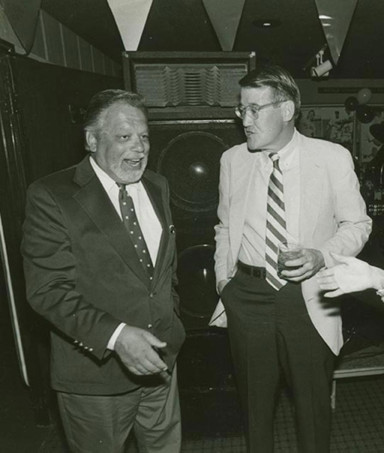
On March 17, 1988, National League President Bart Giamatti (left) and Dodger President Peter O’Malley at the St. Patrick’s Day party at Dodgertown, Vero Beach, Florida. Giamatti would later be elected as Baseball Commissioner for the 1989 season.
The 1988 St. Patrick’s Dinner had an Italian flavor at one point. A chorus of Dodger personnel sang songs of Italy led by Manager Tom Lasorda. He was joined by coach Joe Amalfitano; traveling secretary Billy DeLury; baseball marketing executive Tom Villante; insurance executive and former Dodger pitcher Ralph Branca; and minor league trainer Mike Lopriore, Italians all. And this stellar all Italian singing group included even a non-Dodger employee, the former President of Yale University, author, professor, and the new President of the National League, Dr. A. Bartlett Giamatti.
On occasion, active players took part at entertaining during the dinner. Maury Wills played more than just shortstop for the Dodgers and pleased everyone with his skills on the banjo and guitar. First baseman Tommy Hutton and pitcher Alan Foster played guitars and sang a duet. Jim Grant, a 20-game winner in 1965 for the Minnesota Twins, performed with his group “Mudcat and the Kittens,” three professional women singers, one spring when he pitched for the Dodgers. “Mudcat” was Grant’s baseball nickname. Infielder Nate Oliver also sang at the dinner during his career as a Dodger. In 1994, his first Spring Training at Dodgertown, Chan Ho Park, the first South Korea born player in Major League Baseball history made an appearance at the dinner. Chan Ho received a hearty welcome when he waved hello, sporting a green derby. He revealed his name change for the Irish celebration night would be “Chan O’Park.”
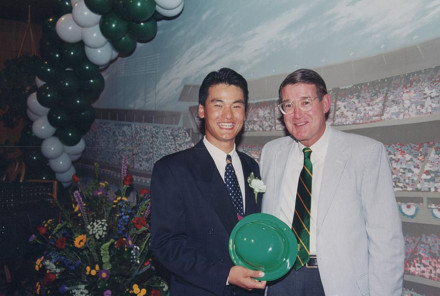
On March 17, 1994, rookie pitcher Chan Ho Park (left) of South Korea is invited to attend the annual St. Patrick’s Day party at Dodgertown, Vero Beach, Florida by Dodger President Peter O’Malley (right). At one point in the festivities, Park was introduced to the appreciative crowd when he came out with a green Irish derby. Park said for the day his name had now been changed to “Chan O’Park,” putting an Irish spin to his Korean name.
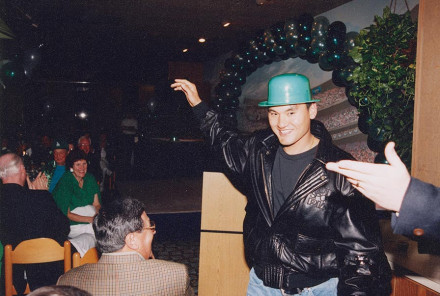
Dodger pitcher Chan Ho Park at Dodgertown, Vero Beach, Florida attends the St. Patrick’s Day party on March 17, 1998. In the foreground is Hall of Fame broadcaster Jaime Jarrin. To the right of Park (back turned) is former Baseball Commissioner Bowie Kuhn, who long supported Peter O’Malley’s involvement for international baseball. Kuhn’s wife Luisa is to his right wearing her own green top. Park pitched 17 seasons in MLB, earning 124 wins to rank as the all-time winningest pitcher from Asia.
The Irish dancers, female front office personnel and wives of Dodger coaches, would participate. The women would practice weeks ahead of time under the leadership of Anne O’Neill, a Dodgertown employee and later executive assistant to the Dodger President. The mistress/master of ceremonies would be varied and the starring role was not limited to the team broadcasters or spokespersons. Dianne Mesa, a minor league and scouting department assistant charmed the crowd with her glow, stories and noted kindness when she hosted the dinner in 1994. But, then again, she had been going to Spring Training in Dodgertown since 1962.
This was a night of performance by the Dodger family. World class entertainers such as Danny Kaye, singer Toni Tennille, and television host Bryant Gumbel, attended St. Patrick’s Day at Dodgertown, but were there as guests and not expected to participate.
Moments of Dodgertown nostalgia were always involved. Longtime members of the organization spoke of their memories of people, places, days, and events of Dodgertown. They would recollect their first day at Dodgertown, persons of influence to their career and also humorous moments never before heard by team leadership. When a familiar name of past years was mentioned by a speaker, as Dodgertown nurse Anastasia Plucker, clubhouse man Herman Levy, or Dodger scout Goldie Holt, the room would fill of nods and sounds of recognition from the audience.
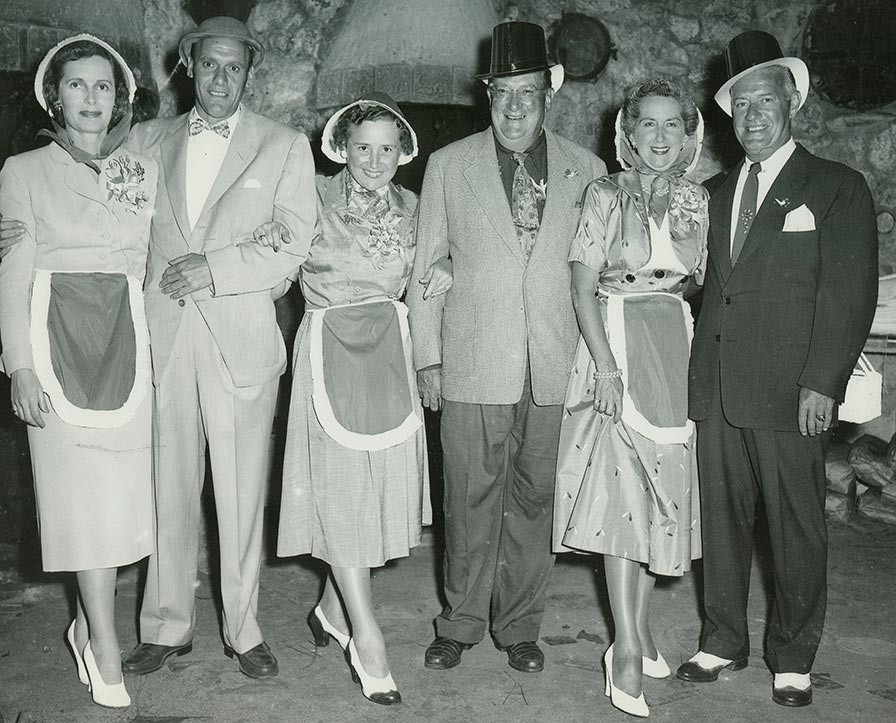
(L-R): Evit and Buzzie Bavasi, Kay and Walter O’Malley, Peg and Fresco Thompson. On St. Patrick’s Day, circa 1953 at Dodgertown, Vero Beach, Florida, Dodger President Walter O’Malley and his wife, Kay host their annual St. Patrick’s Day party at Dodgertown. Joining in the celebration are two Dodger Vice Presidents, Buzzie Bavasi and Fresco Thompson and their wives.
Hall of Fame manager Tom Lasorda, no stranger to a podium, looked back as a player, a scout, minor league manager, and Dodger manager in his years at Dodgertown. He spoke gratefully and kindly of the people at Dodgertown who were important to him in his life and how he was helped when there were more than 600 players in camp.
At one St. Patrick’s Dinner, he told of the time he was a manager for the Licey, Dominican Republic club in winter ball. That night, Licey owner Monchin Pichardo was there to receive a special award, “The Key To Dodgertown.” Tommy told the audience he would go out for dinner after an evening game with the Licey owner. Some of his players would tag along and sit at another table, hoping their team owner would pick up the tab. Lasorda would encourage the owner, Pichardo, to pay for the meal for the players. If the team owner would agree to buy dinner, Tommy would go through certain signs like a baseball coach to let the players know they could order up from the menu. Tommy skillfully ran through his signs like a third base coach and the players watched for the okay signal. If Tommy frantically gave a different set of signals, the players knew the owner was not paying for dinner that night and they were on their own.
St. Patrick’s Day is also a historic day for the leadership of the Dodgers. On March 17, 1970, Peter O’Malley was named Dodger President and his father, Walter, would become the Chairman of the Board. Peter had been Director of Dodgertown from 1962-1965 and advanced in leadership roles within the organization. It was the perfect day to begin the transition of Walter to Peter.
In later years at the dinner, raffles would be conducted. Names of guests would be placed in a Dodger cap or large container and special guests would come up to pull a name for the selection. Fine Irish whiskey, linen and other Irish mementoes were among the prizes.
Peter O’Malley innovated a concept to the tradition of St. Patrick’s Day when he established a presentation of “The Key To Dodgertown.” The selected persons were always longtime employees or guests at Dodgertown who had made significant contributions to the Dodger organization. The Dodger president would introduce the person and explain the background of the honoree’s accomplishments. An actual, ornate key with the person’s name was then presented and a loud, long ovation of acknowledgement for the recipient followed.
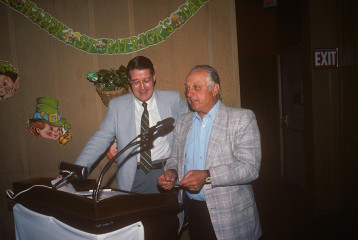
Dodger Manager Tommy Lasorda (right), alongside Dodger President Peter O’Malley, addresses guests of the St. Patrick’s Day Dinner in the dining room at Dodgertown, Vero Beach, Florida, circa mid-1980s. Lasorda shared memories of being at Dodgertown as a player, minor league manager, and as Dodger manager.
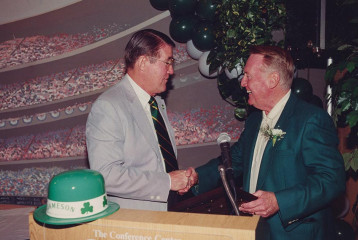
Peter O’Malley (left) and Hall of Fame Dodger broadcaster Vin Scully at Dodgertown, Vero Beach, Florida, for St. Patrick’s Day party, in the mid-1990s. Scully could sing, too. At one St. Patrick’s Day, he trilled the song, “Too Ra Loo Ra Too Lal” to guests at the annual dinner at Dodgertown. The song is an Irish lullaby known for its appearance in the film, “Going My Way”.
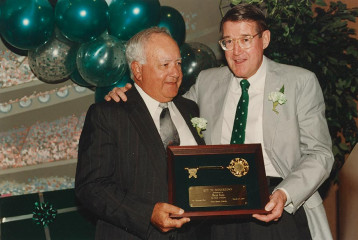
Peter O’Malley (right) presents the “Key to Dodgertown” to Dodger Vice President, Campo Las Palmas Ralph Avila at the annual St. Patrick’s Day party at Dodgertown, Vero Beach, Florida, circa 1997.
In 1998, Hall of Fame Manager Tom Lasorda was presented the “The Key To Dodgertown.” Kevin Modesti of the Los Angeles Daily News wrote Peter O’Malley made the presentation to Lasorda. After Lasorda received the key at the podium, O’Malley asked Lasorda in a low voice, but loud enough for the audience to hear, “Would you like to say a few words? Oh! You would!”
St. Patrick’s Day did not end with the dinner. There was next the post-dinner reception in the Stadium Club Lounge at Dodgertown for guests. Personnel who had early wake-up times the next morning did not linger in order to get a fresh start. Those who did not have a sunrise alarm were encouraged to continue the fun that began with the pre-dinner reception. The photographers, caricature artists, late evening bites with refreshments and the Irish music lasted until even the hardiest person would recognize the lateness of the hour.
The Dodgertown Director in the early 1960s, Peter O’Malley, said, “The memories are absolutely endless. Closing the St. Patrick’s Day was the toughest thing I had to do down here (as Director of Dodgertown). In those days it was an event. There was only one party a year. Everybody went. No one wanted to leave, because leaving meant going back to your room in the barracks where there was no heat. Nobody wanted to leave the party. The party had a lot of good cheer in it. But at 2 or 3 or 4 o’ clock in the morning, as all parties must end, telling your good friends, staff members, umpires, members of the press, that hey, guys, we’ve got to get some sleep. I’ll never forget that.”
So, a grand time was had by all. But, St. Patrick’s Day at Dodgertown was also a signpost. When the club first arrives in Spring Training, everyone has optimism of the upcoming season. The staff has joyous reunions with each other before they scatter to respective clubs for the season. The players need the first 10-14 days to get in playing shape. There is little to do except enjoy the spring weather and being grateful for another baseball season yet to start. Days are languid with anticipation and expectation.
March 18th flips the Dodgertown calendar. On that day, Spring Training becomes serious. The season is fast approaching and players need more playing time in games. Rosters are to be reduced. Veteran players and rookie players are competing for the last positions for the Opening Day roster. Day and nightly meetings are longer and more frequent. Minor league clubs are in the process of being settled from the changes to the big league roster and young minor league players know the importance of playing to continue their career. Last minute trades and assignments occur. In the closing days of March, preparations are made to depart Dodgertown. The first truck with luggage and equipment leaves Dodgertown approximately a week after St. Patrick’s and is the first signal of the end of Spring Training.
The O’Malley family knew of the grind of Spring Training and appreciated the efforts of everyone. Their goal was to bring everyone together, to build a club and provide fun from the rigors of the game while preparing for the long season.
The days of just the men going to Spring Training without their spouses and their families, receded into the past. A new generation of players with wives and young children were seen more often to enjoy Spring Training and the O’Malleys wanted them to have some pleasure in their time at Dodgertown.
March 7, 1979 became a landmark date in Dodgertown when Charlie Blaney, then Dodgertown Director, originated the idea of “Christmas at Dodgertown.” Christmas is a time for family and with the Dodger family in Vero Beach, a celebration was in order.
Christmas was everywhere at Dodgertown. Christmas carols were sung by local choirs or were heard on the sound system. Personal presents hand selected were bought for every child in attendance. Traditional holiday food was prepared for the buffet line with dining tables arranged around the swimming pool. A large Christmas tree was decorated, candy canes were hung with the stocking. Real snow was brought in to throw snowballs. Carnival rides such as a Ferris wheel and a giant slide were included. The grand entrance of Santa Claus was made not by a sleigh, but by a Vero Beach fireman’s engine company with flashing lights and sounding siren. It was beginning to look a lot like Christmas in March. The entire night was a welcome break from the regular schedule, enjoyed by all and appreciated by the team players.
“Christmas at Dodgertown” eventually led to other theme nights to bring the families together. In future years, there would be a Country Western barbecue with all the food, fixings, music, line dancing, and a petting zoo. Attendees were issued cowboy hats and scarves to enhance the look. The fun of that evening led to “50s Night” where Dodgertown serving staff wore white T-shirt or poodle skirts. As the music of Elvis and other 50s legends played, there was dancing to the beat with 50s style food of hamburgers, hot dogs, pizza, fries, chicken, ribs, ice cream, pies, cakes and shakes.
The dining room at Dodger was regularly providing surprises for the guests. Italian Food Night where the entire menu was based on foods from Italy became a standard. Hall of Fame Manager Tom Lasorda would supervise the menu and preparation of the pasta. In 1983, when the television show “M*A*S*H” aired its final episode, the dining room was decorated with the ambience of a military mess hall. Other food nights in the dining room at Dodgertown were Mexican Night, Seafood Night, Japan Night and China Night where the served food and the decorations prevailed.
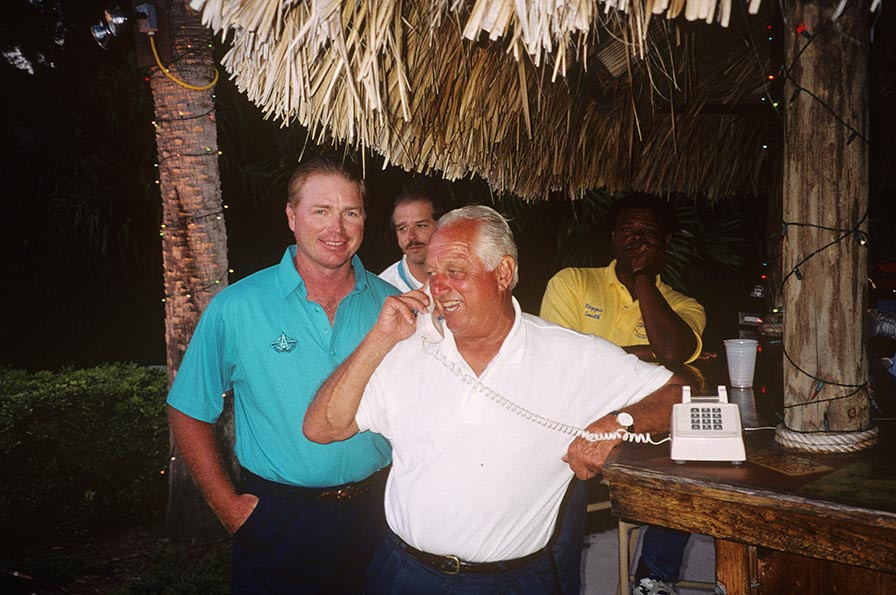
March 5, 1997, near the Dodgertown, Vero Beach, Florida swimming pool, Dodger Manager Bill Russell (left) celebrates the news on the day Tommy Lasorda was elected to the National Baseball Hall of Fame. Russell played 10 seasons as the shortstop for Lasorda and the Dodgers and was a member of the longstanding infield with Steve Garvey, Davey Lopes and Ron Cey.
Smaller, private dinner parties by the pool were held for special guests and significant events to be celebrated. One of the great nights was the landmark when in 1997 Lasorda was elected to the National Baseball Hall of Fame where the former Dodger player and manager enjoyed the fruits of an amazing career.
“Families” and “together” were the watchwords. When Easter would fall during Spring Training, Dodgertown scheduled an Easter Egg Hunt for children of players and staff and a costumed rabbit was on hand. Workout classes were established for interested guests. A Spring Training tennis tournament was also fiercely competitive. When the schedule permitted, day trips to Nassau or the Virgin Islands were scheduled as the Dodgers had on hand, their 720-B jet, named the “Kay’O II.”
How valuable was St. Patrick’s Day at Dodgertown? If a person wanted to use the season performance of a team as a measuring stick during the years of the O’Malley presidencies, then the six World Championships (1955, 1959, 1963, 1965, 1981, and 1988), the 13 National League pennants, the best National League record in the 1950s and 1960s, and the second best record in the National League in the 1970s, the best winning percentage in the National League from 1951 through 1997 by a long shot, and the leadership in professional sports in that time in marketing, public relations, broadcasting, community outreach and service, integration and player development are certainly conclusive arguments of the most successful franchise in American sports, and maybe the world.
Yet, on another measuring stick, there is something that cannot be quantified into wins and championships. St. Patrick’s Day at Dodgertown remains in the minds of everyone who was once there. Dodgertown is a far better place than fictional lands as Camelot or Brigadoon, because it actually existed. The noted Spring Training was years ahead of the South in the integration of living and dining quarters for players and staff. For its courageous and progressive look toward integration for all, the state of Florida dedicated a historical marker and Dodgertown would be named to the U.S. Civil Rights Trail in 2019 based on its unshakeable belief the team needed to be together to play together.
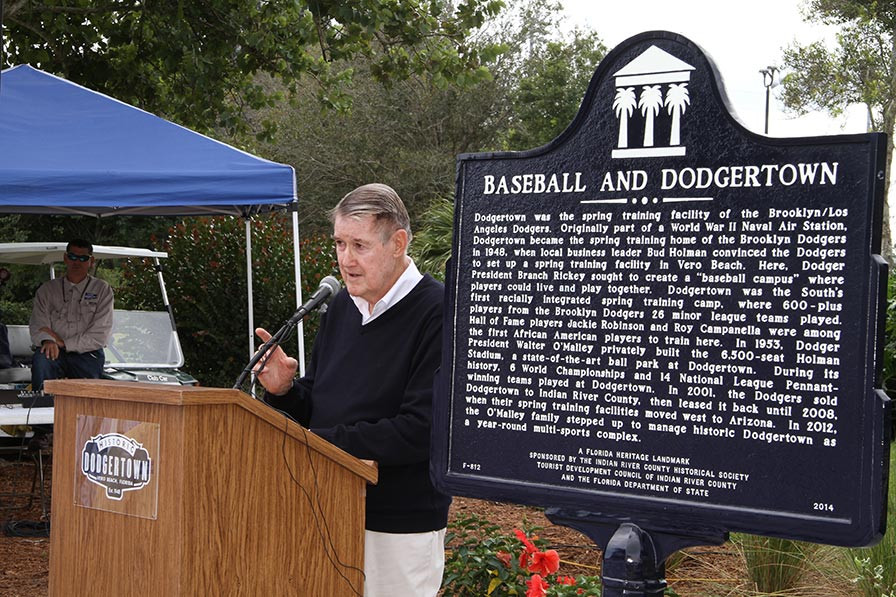
Historic Dodgertown Chairman Peter O’Malley welcomes campers, Dodger legend instructors, guests, and media to the 53rd Los Angeles Dodgers Adult Baseball Camp and speaks at the November 10, 2014 ceremony to unveil a historic marker “Baseball and Dodgertown”, making the site a “Florida Heritage Landmark” in Vero Beach.
What remains of St. Patrick’s Day at Dodgertown are lasting feelings and thoughts in the hearts and minds of those who were there. Somewhere, out there, are still Dodger personnel and guests who on occasion, are likely to think about gentle spring nights in the middle of March and how some of the happiest times of their life were spent in a small city, Vero Beach, Florida with the greatest franchise in sports at a Spring Training base that created a lifetime of memories that will always be known to them as Dodgertown.

